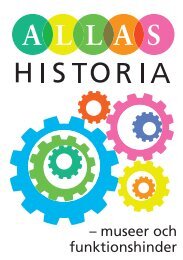- Page 1 and 2:
Claes G. Olsson Omsorg & Kontroll E
- Page 3 and 4:
Claes G. Olsson Omsorg & Kontroll E
- Page 5 and 6:
Innehåll Prolog 9 1 Inledning 13 S
- Page 7 and 8:
5 Omsorg och kontroll genom utbildn
- Page 9 and 10:
Prolog När jag som barn blev bekan
- Page 11 and 12:
Prolog mera. Hur levde till exempel
- Page 13 and 14:
1 Inledning När avhandlingsarbetet
- Page 15 and 16:
Inledning digare publicerad i bokfo
- Page 17 and 18:
Inledning Det var framförallt boke
- Page 19 and 20:
Inledning ”maktens mikrofysik”
- Page 21 and 22:
Inledning Ett annat exempel på en
- Page 23 and 24:
Inledning och aktivitetsbegränsnin
- Page 25 and 26:
Inledning 1700-talet, sedan etabler
- Page 27 and 28:
Inledning centrala temat och en nod
- Page 29 and 30:
Inledning Till den handikapphistori
- Page 31 and 32:
Inledning Som framgått har jag tag
- Page 33 and 34:
2 Folkliga föreställningar och f
- Page 35 and 36:
Folkliga föreställningar och för
- Page 37 and 38:
Folkliga föreställningar och för
- Page 39 and 40:
Folkliga föreställningar och för
- Page 41 and 42:
Folkliga föreställningar och för
- Page 43 and 44:
Folkliga föreställningar och för
- Page 45 and 46:
Folkliga föreställningar och för
- Page 47 and 48:
Folkliga föreställningar och för
- Page 49 and 50:
Folkliga föreställningar och för
- Page 51 and 52:
Folkliga föreställningar och för
- Page 53 and 54:
3 Vetenskapens blick och problemati
- Page 55 and 56:
Vetenskapens blick och problematise
- Page 57 and 58:
Vetenskapens blick och problematise
- Page 59 and 60:
Vetenskapens blick och problematise
- Page 61 and 62:
Vetenskapens blick och problematise
- Page 63 and 64:
Vetenskapens blick och problematise
- Page 65 and 66:
Vetenskapens blick och problematise
- Page 67 and 68:
Vetenskapens blick och problematise
- Page 69 and 70:
Vetenskapens blick och problematise
- Page 71 and 72:
Vetenskapens blick och problematise
- Page 73 and 74:
Vetenskapens blick och problematise
- Page 75 and 76:
Vetenskapens blick och problematise
- Page 77 and 78:
Vetenskapens blick och problematise
- Page 79 and 80:
Vetenskapens blick och problematise
- Page 81 and 82:
Vetenskapens blick och problematise
- Page 83 and 84:
Vetenskapens blick och problematise
- Page 85 and 86:
Vetenskapens blick och problematise
- Page 87 and 88:
Vetenskapens blick och problematise
- Page 89 and 90:
Vetenskapens blick och problematise
- Page 91 and 92:
Vetenskapens blick och problematise
- Page 93 and 94:
Vetenskapens blick och problematise
- Page 95 and 96:
Vetenskapens blick och problematise
- Page 97 and 98:
Vetenskapens blick och problematise
- Page 99 and 100:
Vetenskapens blick och problematise
- Page 101 and 102:
Vetenskapens blick och problematise
- Page 103 and 104:
Vetenskapens blick och problematise
- Page 105 and 106:
4 Pär Aron Borg och undervisningen
- Page 107 and 108:
Pär Aron Borg och undervisningen a
- Page 109 and 110:
Pär Aron Borg och undervisningen a
- Page 111 and 112:
Pär Aron Borg och undervisningen a
- Page 113 and 114:
Pär Aron Borg och undervisningen a
- Page 115 and 116:
Pär Aron Borg och undervisningen a
- Page 117 and 118:
Pär Aron Borg och undervisningen a
- Page 119 and 120:
Pär Aron Borg och undervisningen a
- Page 121 and 122:
Pär Aron Borg och undervisningen a
- Page 123 and 124:
Pär Aron Borg och undervisningen a
- Page 125 and 126:
Pär Aron Borg och undervisningen a
- Page 127 and 128:
Pär Aron Borg och undervisningen a
- Page 129 and 130:
Pär Aron Borg och undervisningen a
- Page 131 and 132:
Pär Aron Borg och undervisningen a
- Page 133 and 134:
Pär Aron Borg och undervisningen a
- Page 135 and 136:
Pär Aron Borg och undervisningen a
- Page 137 and 138:
Pär Aron Borg och undervisningen a
- Page 139 and 140:
Pär Aron Borg och undervisningen a
- Page 141 and 142:
Pär Aron Borg och undervisningen a
- Page 143 and 144:
Pär Aron Borg och undervisningen a
- Page 145 and 146:
Pär Aron Borg och undervisningen a
- Page 147 and 148:
Pär Aron Borg och undervisningen a
- Page 149 and 150:
Pär Aron Borg och undervisningen a
- Page 151 and 152:
Pär Aron Borg och undervisningen a
- Page 153 and 154:
Pär Aron Borg och undervisningen a
- Page 155 and 156:
Pär Aron Borg och undervisningen a
- Page 157 and 158:
Pär Aron Borg och undervisningen a
- Page 159 and 160:
Pär Aron Borg och undervisningen a
- Page 161 and 162:
Pär Aron Borg och undervisningen a
- Page 163 and 164:
Pär Aron Borg och undervisningen a
- Page 165 and 166:
Pär Aron Borg och undervisningen a
- Page 167 and 168:
Pär Aron Borg och undervisningen a
- Page 169 and 170:
Pär Aron Borg och undervisningen a
- Page 171 and 172:
Pär Aron Borg och undervisningen a
- Page 173 and 174:
Pär Aron Borg och undervisningen a
- Page 175 and 176:
Pär Aron Borg och undervisningen a
- Page 177 and 178:
Pär Aron Borg och undervisningen a
- Page 179 and 180:
Pär Aron Borg och undervisningen a
- Page 181 and 182:
Pär Aron Borg och undervisningen a
- Page 183:
Pär Aron Borg och undervisningen a
- Page 186 and 187:
Omsorg och kontroll arbets- och fö
- Page 188 and 189:
Omsorg och kontroll för vuxna blin
- Page 190 and 191:
Omsorg och kontroll Organiseringen
- Page 192 and 193:
Omsorg och kontroll te den dagliga
- Page 194 and 195:
Omsorg och kontroll Definitionen av
- Page 196 and 197:
Omsorg och kontroll svaga ögon”?
- Page 198 and 199:
Omsorg och kontroll söka (inspekte
- Page 200 and 201:
Omsorg och kontroll passar sig mer
- Page 202 and 203:
Omsorg och kontroll Bland underteck
- Page 204 and 205:
Omsorg och kontroll några län i t
- Page 206 and 207:
Omsorg och kontroll han med hästsk
- Page 208 and 209:
Omsorg och kontroll ”Huru blinda
- Page 210 and 211:
Omsorg och kontroll De som lärt et
- Page 212 and 213:
Omsorg och kontroll Handlaren berä
- Page 214 and 215:
Omsorg och kontroll Ett annat probl
- Page 216 and 217:
Omsorg och kontroll Den första res
- Page 218 and 219:
Omsorg och kontroll Religionens bet
- Page 220 and 221:
Omsorg och kontroll sällan betydli
- Page 222 and 223:
Omsorg och kontroll att efter någr
- Page 224 and 225:
Omsorg och kontroll 20 borstbinderi
- Page 226 and 227:
Omsorg och kontroll 1906−1909. Ä
- Page 228 and 229:
Omsorg och kontroll Män Kvinnor Su
- Page 230 and 231:
Omsorg och kontroll Ett annat exemp
- Page 232 and 233:
Omsorg och kontroll dan kroppsarbet
- Page 234 and 235:
Omsorg och kontroll jade om ekonomi
- Page 236 and 237:
Omsorg och kontroll tutet för döv
- Page 238 and 239:
Omsorg och kontroll Trots problemen
- Page 240 and 241:
Omsorg och kontroll både, personli
- Page 242 and 243:
Omsorg och kontroll nen genom inack
- Page 244 and 245: Omsorg och kontroll de i någon må
- Page 246 and 247: Omsorg och kontroll För att underl
- Page 248 and 249: Omsorg och kontroll Hur hade man t
- Page 250 and 251: Omsorg och kontroll den senare. År
- Page 252 and 253: Omsorg och kontroll blinda levde me
- Page 254 and 255: Omsorg och kontroll exempel förvan
- Page 256 and 257: Omsorg och kontroll upp, de ekonomi
- Page 258 and 259: Omsorg och kontroll Det var lytet i
- Page 260 and 261: Omsorg och kontroll som vuxen ha bl
- Page 262 and 263: Omsorg och kontroll le gå ensam ge
- Page 264 and 265: Omsorg och kontroll tigt själv vil
- Page 266 and 267: Omsorg och kontroll en familjeförs
- Page 268 and 269: Omsorg och kontroll han fick se i d
- Page 270 and 271: Omsorg och kontroll lantropin och d
- Page 272 and 273: Omsorg och kontroll andra faktorer
- Page 275 and 276: 6 Omsorg och kontroll - en slutdisk
- Page 277 and 278: Omsorg och kontroll - en slutdiskus
- Page 279 and 280: Omsorg och kontroll - en slutdiskus
- Page 281 and 282: Omsorg och kontroll - en slutdiskus
- Page 283 and 284: Omsorg och kontroll - en slutdiskus
- Page 285 and 286: Omsorg och kontroll - en slutdiskus
- Page 287 and 288: Omsorg och kontroll - en slutdiskus
- Page 289 and 290: Summary Care and Control A Study in
- Page 291 and 292: Summary It is however of course nec
- Page 293: Summary successful businessman. In
- Page 297 and 298: Epilog Äntligen kan jag tacka alla
- Page 299 and 300: Källor och litteratur Källor Ensk
- Page 301 and 302: Litteratur Abu-Lughod, Lila & Lutz,
- Page 303 and 304: Blomberg, Barbro, 2006. Inklusion e
- Page 305 and 306: Eriksson, Bengt-Erik, 1989. Vägen
- Page 307 and 308: Holm, Asger & Gudman, Sven m.fl. (r
- Page 309 and 310: Lundgren, Britta, 1993. ”Den bek
- Page 311 and 312: Olsson, Claes, G., 1996. ”Så lä
- Page 313 and 314: Sandvin, Tveit, Johans, 2008. Ӂ
- Page 315 and 316: Etnologiska skrifter Institutionen
- Page 317 and 318: 34. Wolanik Boström, Katarzyna, Be






